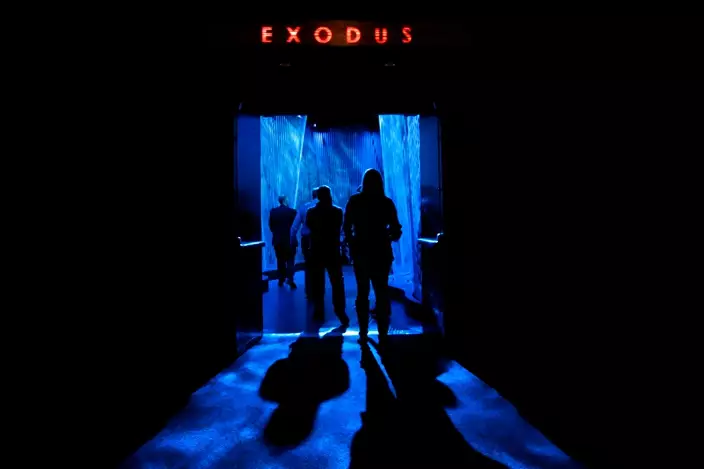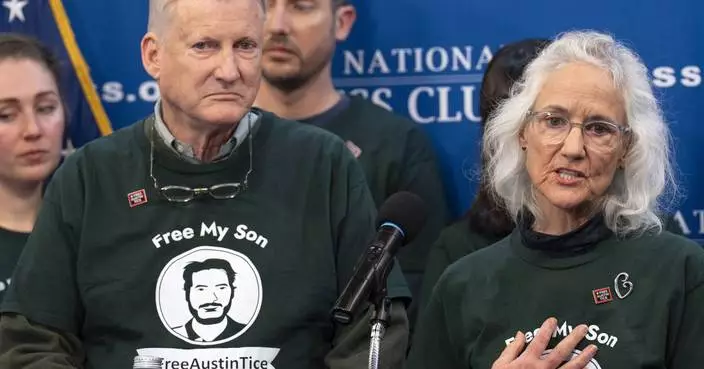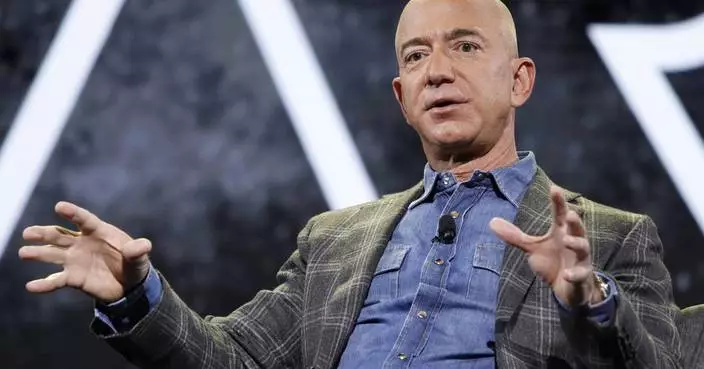Eight years ago, Hobby Lobby president Steve Green found a new way to express his Christian faith. His family's $4 billion arts and craft chain was already known for closing stores on Sundays, waging a Supreme Court fight over birth control and donating tens of millions of dollars to religious groups.

A door opens to the "Exodus" section at the end of the "Passover" presentation inside the Museum of the Bible, Monday, Oct. 30, 2017, in Washington. (AP Photo/Jacquelyn Martin)
Now, Green would begin collecting biblical artifacts that he hoped could become the starting point for a museum.
On Friday, that vision will be realized when the 430,000-square-foot (39,948-square-meter) Museum of the Bible three blocks from the U.S. Capitol. The $500 million museum includes pieces from the family's collection from the Dead Sea Scrolls, towering bronze gates inscribed with text from the Gutenberg Bible and a soundscape of the 10 plagues, enhanced by smog and a glowing red light to symbolize the Nile turned to blood.

Cary Summers, president of the Museum of the Bible, walks through an exhibit at the museum, Monday, Oct. 30, 2017, in Washington. The museum was built by the owners of Hobby Lobby, cost $500 million to build, covers 430,000 square feet and is a few blocks from the U.S. Capitol. (AP Photo/Jacquelyn Martin)
It is an ambitious attempt to appeal simultaneously to people of deep faith and no faith, and to stand out amid the impressive constellation of museums in Washington. The Bible exhibits are so extensive that administrators say it would take days to see everything.
Green says the institution he largely funded is meant to educate, not evangelize, though critics are dubious. Museum administrators have taken pains to hire a broad group of scholars as advisers. Lawrence Schiffman, a New York University Jewish studies professor and Dead Sea Scrolls expert, called the museum a "monument" to interfaith cooperation. Exhibits are planned from the Vatican Museum and the Israel Antiquities Authority.

An exhibit discussing slavery in the United States is displayed inside the Museum of the Bible, Monday, Oct. 30, 2017, in Washington. (AP Photo/Jacquelyn Martin)
"There's just a basic need for people to read the book," Green said. "This book has had an impact on our world and we just think people ought to know it and hopefully they'll be inspired to engage with it after they come here."
The last major splash the Greens made in Washington was over their religious objections to birth control. In 2014, Hobby Lobby persuaded the U.S. Supreme Court to exempt for-profit companies like theirs from the contraception coverage requirement in President Barack Obama's Affordable Care Act. That culture war victory has in part colored reactions to the museum even before it opens.

Steve Green, the owner of Hobby Lobby and a founder and major backer of the Museum of the Bible, poses for a portrait at the museum, Monday, Oct. 30, 2017, in Washington. The museum cost $500 million to build, covers 430,000 square feet and is a few blocks from the U.S. Capitol. (AP Photo/Jacquelyn Martin)
The Oklahoma company also had to pay a $3 million fine and return artifacts after federal prosecutors said they got caught up in an antiquities smuggling scheme. Steve Green said the company had been naive in doing business with the dealers. Items at the center of the fines were never destined for the museum, administrators say. Of the 1,100 items the museum owns, 300 come from the Greens' personal collection.

Steve Green, the owner of Hobby Lobby and a founder and major backer of the Museum of the Bible, poses for a portrait at the museum, Monday, Oct. 30, 2017, in Washington. (AP Photo/Jacquelyn Martin)
But skepticism surrounding the intent of the project has focused more on the Greens' record of putting their fortune and influence behind spreading their particular religious beliefs. The museum will be the centerpiece of several of the family's efforts, including sponsoring research on the Bible and promoting a Bible curriculum they hope will be used in U.S. public schools. An initial attempt in an Oklahoma school district was withdrawn following complaints the lessons weren't neutral.

People preview the exhibit "The World of Jesus of Nazareth" at the Museum of the Bible, Monday, Oct. 30, 2017, in Washington. (AP Photo/Jacquelyn Martin)
"The museum is a massive advertisement for the curriculum," said Mark Chancey, a religious studies professor at Southern Methodist University, who has critically analyzed content of the Bible lesson plans.
A new book written by Green and his wife, Jackie, about how they developed the museum seems to send mixed signals about their goals.

Exhibits are readied inside the Museum of the Bible, Monday, Oct. 30, 2017, in Washington. The project is largely funded by the conservative Christian owners of the Hobby Lobby crafts chain. Hobby Lobby president Steve Green says the aim is to educate not evangelize. (AP Photo/Jacquelyn Martin)
In "This Dangerous Book, How the Bible Has Shaped Our World and Why It Still Matters Today," the Greens write of the museum: "We're not creating a place to proselytize." They also write, "We believe there are multiple applications for Scripture, but only one interpretation," and "Time and time again, evidence has shown the Bible to be accurate."
Still, the museum avoids debates over interpreting the Bible and over contentious issues such as evolution and marriage.

Security workers stand inside a large open stairwell area at the Museum of the Bible, Monday, Oct. 30, 2017, in Washington. (AP Photo/Jacquelyn Martin)
Separately, critics have seized on a changing mission statement of the museum from its earliest days, when founders said they aimed to prove the authority of the Bible, to a new, more neutral goal of inviting people to learn more about the Bible. Museum president Cary Summers described the change as a natural progression as the project moved ahead.
But John Fea, a historian at Messiah College in Pennsylvania, points to the family's goal of helping people "engage with" the Bible as a telling indication about what the Greens hope to achieve. He said the "Bible engagement" concept was popularized by the American Bible Society in the 1990s amid concern that people who owned copies of the Scriptures weren't necessarily reading them.

A door opens to the "Exodus" section inside the Museum of the Bible, Monday, Oct. 30, 2017, in Washington. The project is largely funded by the conservative Christian owners of the Hobby Lobby crafts chain. Hobby Lobby president Steve Green says the aim is to educate not evangelize. But skeptics call the project a Christian ministry disguised as a museum. (AP Photo/Jacquelyn Martin)
Fea said advocates for this strategy ultimately hope the Bible will inspire a desire to learn more and maybe accept Christ.
"There's a public face to this Bible engagement rhetoric, and then there's a private aspect of what it really means," Fea said. "It debunks the whole notion that this is just a history museum."
Green's response to such arguments: Visit the museum and decide for yourself.
Located near the National Mall, the building alone has been designed to inspire a sense of wonder. The Gutenberg gates flank the entrance. A 140-foot LED display runs the length of the entrance hall ceiling, bathing the lobby in a changing array of color. The floors are a mix of shimmering marble from Denmark and Tunisia, complemented by columns of Jerusalem stone. From two high stories, a glass atrium curves from ceiling to floor, echoing the shape of a scroll and providing a clear view of the Capitol dome and the Washington Monument.
A section dedicated to the Bible's modern-day influence includes a replica of the Liberty Bell, inscribed with a verse from Leviticus, and exhibits touching on slavery, abolition and the civil rights movement. A motion simulator called Washington Revelations creates the sensation of flying over the nation's capital to see Bible inscriptions and references in buildings and monuments throughout the city.
Festivities surrounding the opening include a gala fundraiser for the museum at the Trump International Hotel, a dedication ceremony at the museum with Roman Catholic, Jewish and Protestant religious leaders, and a gala in the museum ballroom.
The Greens invited House and Senate leaders to join the events, along with Vice President Mike Pence and members of Trump's Cabinet. Pence said through a spokesman he would not participate. Some Cabinet members are expected to attend the fundraiser, a museum spokeswoman said.









